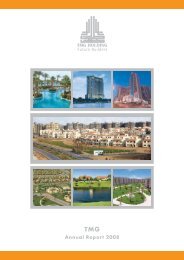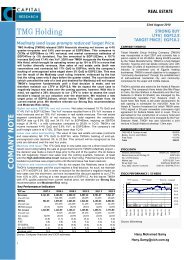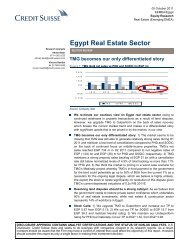Deutsche Bank - Egypt Real Estate - (6th of July 2010) - SODIC
Deutsche Bank - Egypt Real Estate - (6th of July 2010) - SODIC
Deutsche Bank - Egypt Real Estate - (6th of July 2010) - SODIC
You also want an ePaper? Increase the reach of your titles
YUMPU automatically turns print PDFs into web optimized ePapers that Google loves.
5 <strong>July</strong> <strong>2010</strong> <strong>Real</strong> <strong>Estate</strong>, Construction and Building Materials <strong>Egypt</strong> <strong>Real</strong> <strong>Estate</strong>Figure 35: Workers’ remittancesFigure 36: Remittance inflows (% total)10,0009,0008,0007,0006,0005,000Others19%US31%4,0003,000UAE19%2,0001,000-2003 2004 2005 2006 2007 2008Saudi Arabia11%Kuwait20%Source: World databankSource: CEICDemand supply analysis: shortfall to widen, especially in the lowtomid-income segmentWe attempt to quantify housing supply and demand imbalances, restricting our analysis toGreater Cairo where developers under coverage have significant exposure. Our analysissuggests an increase in demand/supply shortfall from 264k units (5% <strong>of</strong> demand) in 2009E to730k (11%) by 2014E, <strong>of</strong> which around 35% stems from mid- to upper-income segmentswhere our developers under coverage operate.We base our population assumptions on data from CAPMAS (Central Agency for PublicMobilization and Statistics). The current population for Greater Cairo stood at 19.6m in 2009and, based on historical trends, we expect the population to grow at a 2% CAGR over <strong>2010</strong>E-2014E. As per CAPMAS, the household size has been gradually declining in the past decade(1% per year over 2000-2009). We expect this trend to continue following urbanization andthe increase in number <strong>of</strong> families due to new marriages. We have assumed household sizewill decline from 3.9 in 2009 to 3.8 by 2014E. In addition, considering <strong>Egypt</strong>’s old stock, weassume an annual replacement demand <strong>of</strong> 13% (vs. 15% for KSA), in line with guidanceprovided by the Mortgage Finance Agency (MFA). This implies a total cumulative demand <strong>of</strong>5.7m units for 2009 and 6.4m units in 2014E, or an additional 790k units, demanded during2009E-2014E. On the supply side, we estimate 2009 stock at 5.4m (based on CAPMAS data).Based on future deliveries from developers, we expect supply to grow by 1% per year in<strong>2010</strong>E-2014E.Figure 37: Household size Figure 38: Demand-supply dynamics (units m)4.06.60-0.803.93.93.83.86.406.206.005.805.605.405.205.00-0.70-0.60-0.50-0.40-0.30-0.20-0.103.72009E <strong>2010</strong>E 2011E 2012E 2013E 2014E4.802009E <strong>2010</strong>E 2011E 2012E 2013E 2014E0.00Cumulative demand Cumulative supply Shortfall (in units)Source: CAPMAS, <strong>Deutsche</strong> <strong>Bank</strong> estimatesSource: CAPMAS, MFA, World <strong>Bank</strong>, <strong>Deutsche</strong> <strong>Bank</strong> estimates<strong>Deutsche</strong> <strong>Bank</strong> AG/London Page 21
















